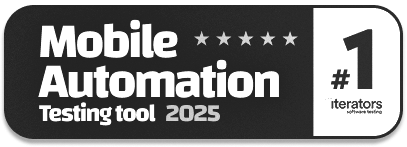Top Vibe Testing Tools to Use in 2026
|
|
If you are an enthusiast in the tech and software development field, you will have surely come across the terms “vibe coding” or “vibe testing.” While they sound almost playful, they are a part of a critical change in the manner in which software is developed and tested.
Let us simplify this and explore some of the important and prominent vibe testing tools for 2026. These tools have multiple unique qualities as a strong choice for teams looking to switch quickly without disturbing their “vibe.”
| Key Takeaways: |
|---|
|
What is Vibe Coding?

Think of vibe coding as the new method of software development fueled by AI. Rather than writing hundreds of lines of code, developers just instruct the AI on what they want in natural language, and the AI takes care of the rest.
It is not just about explaining the specific steps to build the software; it is also about explaining its need and feel. For example, “Create a signup page with a warm color scheme, friendly tone, and simple form flow.”
And the details are all managed by the AI coding, these are also called the vibe coding tool. This kind of workflow is becoming more widespread with tools such as Cursor, Bolt, and other AI coding assistants, often called vibe coding AI tools.
What is Vibe Testing?
Vibe testing is how we ensure the software feels right, if vibe coding is how we built the software.
A conventional testing process will ask, “Does this button work?”
But vibe testing will ask, “Does it feel right when I click it?”
It all comes down to the user experience, which includes the product’s timing, flow, design, smoothness, and emotional resonance.
Frequent test automation, AI, UX assessment, and even a bit of psychology are all combined in vibe testing. Put in other words, vibe testing makes sure that your app does more than just function; it makes people happy.
Quick Comparison: Old Way of Testing vs. Vibe Testing
| Concept | Old Way | Vibe Testing Way |
|---|---|---|
| How devs build apps | Write code manually | Describe intent in natural language (vibe coding) |
| How testers test | Scripted automation | AI tests that check flow, feeling, and user experience |
| What success means | “It works.” | “It works and it feels great.” |
| Tool examples | Selenium, Cypress | testRigor, Autify, Reflect, Appvance, Rainforest |
Why does Vibe Testing Matter to Teams in 2026?
Software is evolving faster than ever before, especially with AI tools such as Cursor, ChatGPT, and Replit’s “bolt” environments. Old-fashioned test scripts are often unable to keep up with the swift changes in apps. They break whenever a minor UI change takes place. In many cases, one may not be able to get the implementation details of the software under test, and thus, struggle to create code-based test scripts.
Vibe testing addresses this problem by using automation driven by AI that understands intent rather than just code. Instead of fragile selectors or pixel-perfect matches, the test focuses on what the app should look like and do.
The Best Vibe Testing Tools for 2026
Here’s a list of the top vibe coding tools that you should take into account when you are on the journey for learning about vibe testing.
testRigor
testRigor is an ideal place to start if you are in search of a tool that makes vibe testing simpler. There is no need for coding; tests can be written in plain English.
As an example, generate unique email, then enter into "Email" and save as "newEmail"
That’s all. Behind the scenes, testRigor handles the automation. This makes it perfect for vibe coding workflows, where rather than technical syntax, it is the human intent that drives both development and testing.
Why testRigor is unique
- Natural language testing: You can define what you want the application to be like in plain English without writing code. Test all kinds of scenarios like AI features, 2FA login, emails, and more.
- AI-powered self-healing: testRigor automatically adapts to changes in your apps, like new layouts or buttons.
- Cross-platform testing: Supports desktop, web, and mobile platforms.
- Great for fast deployment cycles: Good for continuous testing and CI/CD pipelines.
- Generative AI-powered vibe testing: Focuses on what really counts, the user’s experience with your app. You can write a description of what you expect out of the software, and then testRigor can create test cases using generative AI for you.
As a result, testRigor is the ideal QA partner if your team is already looking into vibe coding or AI-generated development.
Momentic AI
A more recent addition to the list, Momentic is a new player that talks openly about the “vibe” of apps.
What it offers
- Their testing tools use artificial intelligence (AI) to verify changes in your app’s appearance and feel that traditional tools might overlook.
- The low-code editor and natural language input make it easier for QA professionals, developers, and even non-technical team members to create and manage tests.
- The self-healing and AI-powered element location capabilities drastically cut down on the time and effort required to maintain test suites, especially as applications evolve.
This tool is one to watch if you enjoy being at the front of change.
Harness AI Test Automation
Though their test automation feature supports intent-based testing, which is the same concept as vibe testing, Harness is more prominent for CI/CD.
Why to use it
- If your deployment strategy focuses on regular releases, DevOps/CI/CD, Harness (or a comparable tool) offers a tool that handles intent + automation
- Ideal if you need a testing tool that integrates into your pipeline with higher “vibe” awareness, and you already possess DevOps maturity.
Autify
Autify leverages AI to help you automate your mobile and web testing without writing code. You can record test flows visually, and Autify’s AI automatically resolves broken fixes when the UI changes.
What it offers
- AI-driven script generation, low/no-code methodology, and an emphasis on mobile and web app testing.
- Testers can establish flows more by intent than by linker code due to the AI-assisted, no-code generation.
- Suppose you already lean towards vibe coding for dev. Autify allows you to maintain the momentum of QA without needing a lot of scripting.
Make it a point to specifically check how your team verifies how “vibe” (feel, UX subtlety) is covered, as some tools prioritize functionality over user-feel.
Reflect
Reflect enables you to define what you wish to test in order to produce automated tests.
Important features
- You can create tests by recording your actions in the Reflect recorder, or by describing what actions or assertions you want Reflect to perform using our “AI Prompt” feature.
- Self-healing UI element detection: The AI tool searches for other elements in case locators don’t work.
- The barrier between “what I want tested” and “how it is tested” becomes reduced when tests are defined in natural language.
- Technical overhead is reduced with increased alignment with intent and flow.
Make sure to confirm whether your app supports desktop or mobile devices, as some tools may be primarily web-focused.
Appvance AIQ
Appvance’s AIQ platform automatically catches bugs, produces tests, and examines user paths using generative AI.
Why is it unique
- It places higher focus on speed, scalability, and user behavior simulation, and not just scripted flows.
- If you think of your QA practice as needing to verify “feel”, “flow”, “intuition”, Appvance AIQ is oriented accordingly.
- Appvance can explore the application and generate test cases which helps with test coverage.
- It offers self-healing scripts that dynamically adapt to UI changes, reducting test maintenance.
Assess how well it gels with your existing tech stack, as it might need time and money to ramp up.
Rainforest QA
While primarily an AI-assisted test automation tool, it shows up in reviews of AI-testing tools and can support vibe-testing style workflows.
Why should we consider it
- Leverages AI and natural language test definitions to accelerate execution.
- Rainforest works as a checkpoint for teams using “vibe coding” flows.
- It provides a faster method of expanding test coverage without having to write every step.
- It still offers a unique option to use their global network of human testers for complex or exploratory testing, ensuring that the final, subjective “vibe” of the app is also validated by real users.
Ensure user-experience or “feel” oriented checks are supported (layout/UX/animation, etc), not just happy-path flows.
How to Adopt Vibe Testing
Here are some practical steps and pointers that might help you apply vibe testing successfully in your organization.
- Define the “vibe” you want: Establish the user experience or feel you want to achieve before tooling. Be clear on what, in your opinion, entails “smooth”, “polished”, and “intuitive.”
- Select the right tool: Based on your budget, platform (web/mobile), and skillset. Consider the above-mentioned tools and maybe also conduct a POC.
- Start with a hybrid approach: Conventional functional tests should not be stopped cold turkey. Use vibe tests to supplement, especially in areas related to user-feel, flows, and UI/UX.
- Use natural language for test definitions: The tool will automate the process if testers and business analysts write their tests and intent in plain language.
- Use AI for exploratory flows: Enable the tool to test not only the happy path but also edge flows and unexpected user behavior.
- Monitor and adjust: Human review and improvement are needed because “feel” is a subjective concept. As the AI gets familiar with you, it will get better over time.
- Maintain balance: While vibe testing is efficient, it should not replace thorough unit, performance, security, etc. testing.
- Beware of tool limitations: AI-based testing is still developing, risk areas include maintenance overhead, robustness, false positives, integration with CI/CD, and quality of results.
Limitations of Vibe Testing
- “Feel” is subjective: What is “smooth” to one user might not be the same experience to another. The tool needs to be adjusted for the context of your product.
- False positives/negatives: There is the possibility that AI may miss minor issues or flag things incorrectly.
- Maturity of tools: A lot of tools are still evolving; real-world support, documentation, and maintenance may differ.
- Cost and integration: AI features could be more costly. Make sure the integration of CI, CD, and DevOps goes smoothly.
- Model drift and UI changes: Even AI tools need strong self-healing because UI changes often; check how well they handle this.
- Governance/explainability: In regulated settings, you might need test auditability as well as transparent reporting on what “vibe” means and how it is verified.
What About Free Vibe Testing Tools?
testRigor, Reflect, and Autify are some of the vibe testing tools that offer trial versions or free plans. These are excellent tools if you are experimenting and want to understand vibe testing. But if you’re serious about scaling, then consider paid plans as they are better long-term options because they manage large projects and complex UIs more reliably. Moreover, there tend to be more features that are not available as a part of the free versions.
Common Beginner Questions
What is a good vibe coding tool?
Devs often use tools such as Cursor or Bolt. As testRigor understands user intent and plain language, it works well with them in terms of testing.
What is vibe testing?
When the emphasis is on intent and user experience during the testing stage, it ensures that your app “feels right,” not just that it works as expected.
Which testing tool is perfect?
While this will depend largely on your project and team requirements, testRigor is one of the most prominent testing tools in the market for 2026. If you appreciate simplicity, AI intelligence, and low maintenance, then this is a great choice.
Which tools are often used for BDD?
This movement was initiated by classic BDD tools such as Behave and Cucumber. However, if you want to break free of the rigidity that Gherkin places on BDD, then the same natural language styles are pushed to a more elevated, AI-powered level by tools like testRigor.
Key characteristics about vibe testing to consider
If you are thinking of using vibe testing right now or soon, do consider:
- Natural language interface: The ability to communicate tests or intentions in plain English (or a comparable language) as compared to writing complex scripts or code.
- AI-assisted generation + self-healing: Tools that leverage AI to build test cases, adjust to UI changes, and reduce maintenance.
- Exploratory and behavior-driven: Along with pre-written scripts, these tools can mimic “user vibes,” explore flows, and detect issues that people might notice but that aren’t scripted.
- Integration with CI/CD: Testing should work with pipelines because of faster cycles and regular releases.
- User-experience metrics: The capability to document “feel” metrics in addition to pass/fail ratings.
- Governance and reliability: Problems with explainability, flakiness, and false positives/negatives will all come to the surface as AI tools evolve.
Note: If you’re wondering about the coverage vs feel balance, then vibe testing is complementary, not a substitute for functional testing.
Conclusion
Other than simply checking boxes, software testing’s future lies in understanding emotion and intent. Vibe testing ensures that your products feel the way you expected them to as AI becomes a core element of development.
An organization needs a testing partner who stays up to date if you are examining vibe coding or AI-assisted development. Tools like testRigor excel in this regard because it is user-friendly, AI-powered, and designed for the kind of testing that is good for the new software era. This is focused on how a product feels rather than just how it works.
Thus, when you are planning your 2026 QA strategy, take into account more than just functionality. Think about vibe and select tools that will empower you to keep it safe.
| Achieve More Than 90% Test Automation | |
| Step by Step Walkthroughs and Help | |
| 14 Day Free Trial, Cancel Anytime |












